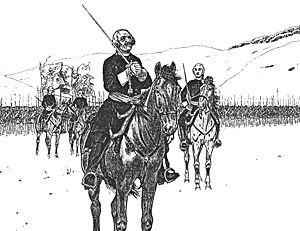
The Second Silesian War lasted from August 1744 until 25 December 1745. It marked the end of the War of Austria Succession and confirmed Frederick the Second in his land grab of the Austrian province of Silesia. The Battle of Kesseldorf was the last major battle between the Prussians and the Austro-Saxon armies.
Prince Leopold of Anhalt-Dessau, "the Old Dessauer", before the Battle of Kesselsdorf. He is shown saying his prayer before the battle: "Heavenly Father, graciously aid me this day; but if thou shouldst not be so disposed, lend not, at least, thy aid to those scoundrels, the enemy, but passively await the issue." Picture after Richard Knotel.
At the beginning of 1745 the death of Charles VI, erstwhile Emperor of the Holy Roman Empire, and some brilliant political manoeuvering by Austria left Frederick isolated and in a very shaky state. He was forced into the strategic defensive by the military manoeuvering of Charles of Lorraine and the Saxons under Marshal Rutowski. Since their armies were too weak to tackle Frederick independantly, they did not want to offer battle with Frederick without acting in concert. Therefore, the first part of the year was spent in reinforcing the respective Allied armies and in manoeuvering.
All this changed with the battles of Hohenfriedberg on June 4 and the Sohr on September 30 1745. In these two battles Frederick decisively defeated the Pragmatic Alliance and shut off their attempt to retake Silesia. This was not enough, however, to end the war. That waited for the battle of Kesselsdorf on December 14.
The Short Winter Campaign
After his victory at Sohr, Frederick believed that the war was effectively over and that peace was inevitable. With this in mind, his army retired into winter quarters and the king returned to Berlin. This sense of security was short-lived, however, when a Swedish diplomat informed Frederick that the Austrians and Saxons were planning a winter campaign, advancing from Saxon Lusatia into the heart of Brandenburg. Frederick planned a two-pronged counterattack: the Old Dessauer would take his army at Halle across the Elbe and into northern Saxony, while Frederick would lead the Silesian army into Lusatia from the east.
Prince Charles' Austrian army managed to avoid any serious combat with Frederick's army, save for the rearguard action at Hennersdorf. Meanwhile, Rutowski's Saxons, reinforced by 6,000 Austrians under General Grunne, caught up with the Old Dessauer's army at Kesselsdorf, some six miles southwest of Dresden.
Battle of Kesseldorf
Back to Seven Years War Asso. Journal Vol. VII No. 1 Table of Contents
Back to Seven Years War Asso. Journal List of Issues
Back to Master Magazine List
© Copyright 1993 by James Mitchell
This article appears in MagWeb.com (Magazine Web) on the Internet World Wide Web.
Other articles from military history and related magazines are available at http://www.magweb.com